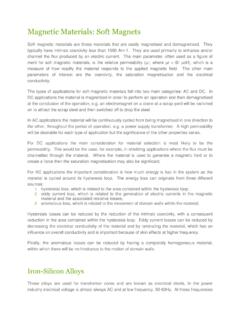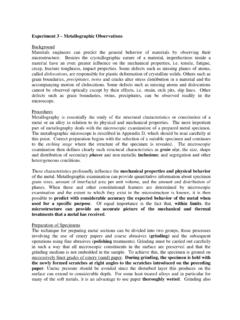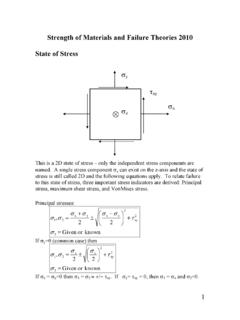Transcription of Experiment 3 Metallographic Observations
1 Experiment 3 Metallographic Observations Background Materials engineers can predict the general behavior of materials by observing their microstructure. Besides the crystallographic nature of a material, imperfections inside a material have an even greater influence on the mechanical properties, tensile, fatigue, creep, fracture toughness, impact properties. Some defects such as missing planes of atoms, called dislocations, are responsible for plastic deformation of crystalline solids. Others such as grain boundaries, precipitates, twins and cracks alter stress distribution in a material and the accompanying motion of dislocations.
2 Some defects such as missing atoms and dislocations cannot be observed optically except by their effects, strain, etch pits, slip lines. Other defects such as grain boundaries, twins, precipitates, can be observed readily in the microscope. Procedures Metallography is essentially the study of the structural characteristics or constitution of a metal or an alloy in relation to its physical and mechanical properties. The most important part of metallography deals with the microscopic examination of a prepared metal specimen. The Metallographic microscope is described in Appendix D, which should be read carefully at this point.
3 Correct preparation begins with the selection of a suitable specimen and continues to the etching stage where the structure of the specimen is revealed. The microscopic examination then defines clearly such structural characteristics as grain size, the size, shape and distribution of secondary phases and non-metallic inclusions; and segregation and other heterogeneous conditions. These characteristics profoundly influence the mechanical properties and physical behavior of the metal. Metallographic examination can provide quantitative information about specimen grain sizes, amount of interfacial area per unit volume, and the amount and distribution of phases.
4 When these and other constitutional features are determined by microscopic examination and the extent to which they exist in the microstructure is known, it is then possible to predict with considerable accuracy the expected behavior of the metal when used for a specific purpose. Of equal importance is the fact that, within limits, the microstructure can provide an accurate picture of the mechanical and thermal treatments that a metal has received. Preparation of Specimens The technique for preparing metal sections can be divided into two groups, those processes involving the use of emery papers and coarse abrasives (grinding) and the subsequent operations using fine abrasives (polishing treatments).
5 Grinding must be carried out carefully in such a way that all microscopic constituents in the surface are preserved and that the grinding medium is not embedded in the sample. To achieve this, the specimen is ground on successively finer grades of emery (sand) paper. During grinding, the specimen is held with the newly formed scratches at right angles to the scratches introduced on the preceding paper. Undue pressure should be avoided since the disturbed layer this produces on the surface can extend to considerable depth. For some heat treated alloys and in particular for many of the soft metals, it is an advantage to use paper thoroughly wetted.
6 Grinding also removes surface deformations. After grinding, the specimen is washed thoroughly in water and then polished. Mechanical polishing can best be carried out by holding the specimen against a rotating disc covered with a suitable pad that is impregnated with either a suspension of polishing alumina in water or diamond dust oil. Mounting of Specimens It is frequently convenient to mount small specimens in bakelite or acrylic to aid specimen preparation, grinding, polishing and etching. You will be given instructions on the use of the apparatus for mounting specimens. The basic idea is that bakelite powder is thermosetting.
7 Therefore the specimen is placed in a tube 2/3 filled with powder. The tube is heated while the powder is compressed. The pressure and heat are removed when the powder has completely melted and the bakelite has set. To maintain orientation small shot are sometimes placed next to the specimen in some identifying arrangement. Grinding and Polishing Procedure The following instructions indicate the general method to be used in specimen preparation. The edges of cylindrical metal specimens must first be beveled off to avoid damaging the polishing cloths. For Mg and Al and their alloys, use the aluminum polishing wheels.
8 Stage Abrasive Lubricant Cloth Rough Grinding Silicon Carbide Tap Water Fine Grinding Grit 240 Grit 320 Grit 400 Grit 600 Rough Polishing Gamma Alumina Tap Water Rayon Final Polishing Gamma Alumina Tap Water Rayon It is important that abrasive is not carried from one part of a sequence to another.
9 Therefore, you must wash both the specimens and your hands between each step. When grinding the specimens, they are rubbed forward in one direction until the surface is completely ground, that is, until only grinding marks due to the particular paper can be seen on the whole surface. For soft metals, further grinding for a short time is advisable after this condition is reached to remove any sub-surface deformation produced in previous operations. The direction of grinding is changed from paper to paper so that the removal of previous grinding marks is easily observed. Polishing is carried out on cloth covered rotating wheels.
10 During the polishing, the specimen should be held firmly in contact with the polishing wheel, undue pressure should be avoided. During polishing, the specimen should be rotated or moved around the wheel to give an even polish. The specimens must be washed and dried before both polishing steps. Etching Etching is done to bring out the structure of the polished specimen. It is usually performed by subjecting the polished surface to the chemical action of an appropriate reagent. However, the polished specimen should first be examined unetched. Inclusions, flaws, scratches and other defects can be observed in this way, and if they are identified before etching, subsequent confusion and misinterpretation can be largely avoided.














